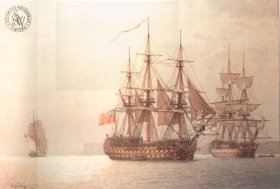 Glory (1788) and Valiant | |
| History | |
|---|---|
| | |
| Name | HMS Valiant |
| Builder | Perry, Green & Wells, Blackwall |
| Laid down | April 1805 |
| Launched | 24 January 1807 |
| Fate | Broken up, 1823 |
| General characteristics [1] | |
| Class & type | Repulse-class ship of the line |
| Tons burthen | 1718 (bm) |
| Length | 174 ft (53 m) (gundeck) |
| Beam | 47 ft 4 in (14.43 m) |
| Depth of hold | 20 ft (6.1 m) |
| Propulsion | Sails |
| Sail plan | Full-rigged ship |
| Armament |
|
HMS Valiant was a 74-gun third-rate ship of the line of the Royal Navy, launched on 24 January 1807 at Blackwall Yard. [1]
Contents
She took part in the attack on Copenhagen in 1807 and in the action against French warships in the Basque Roads from 11 to 25 April 1809 (Battle of Aix Roads) under Lord Gambier and Lord Cochrane. [2]
On 17 June 1813, Valiant was in company with Acasta when they came upon HMS Wasp in pursuit of an American brig off Cape Sable. [3] The three British ships continued the chase for another 100 miles (160 km) before they finally were able to capture the brig. She was the letter of marque Porcupine, of more than 300 tons, and was carrying a valuable cargo of brandy, wine, silks, dry goods and other merchandise from Bayonne to Boston. Captain Robert Dudley Oliver of Valiant described Porcupine as being only eight months old and an uncommonly fast sailer. After the capture, Wasp, which had recaptured a prize that the privateer Young Teazer had taken, sailed in search of the privateer. [3]
She was broken up in 1823. [1]